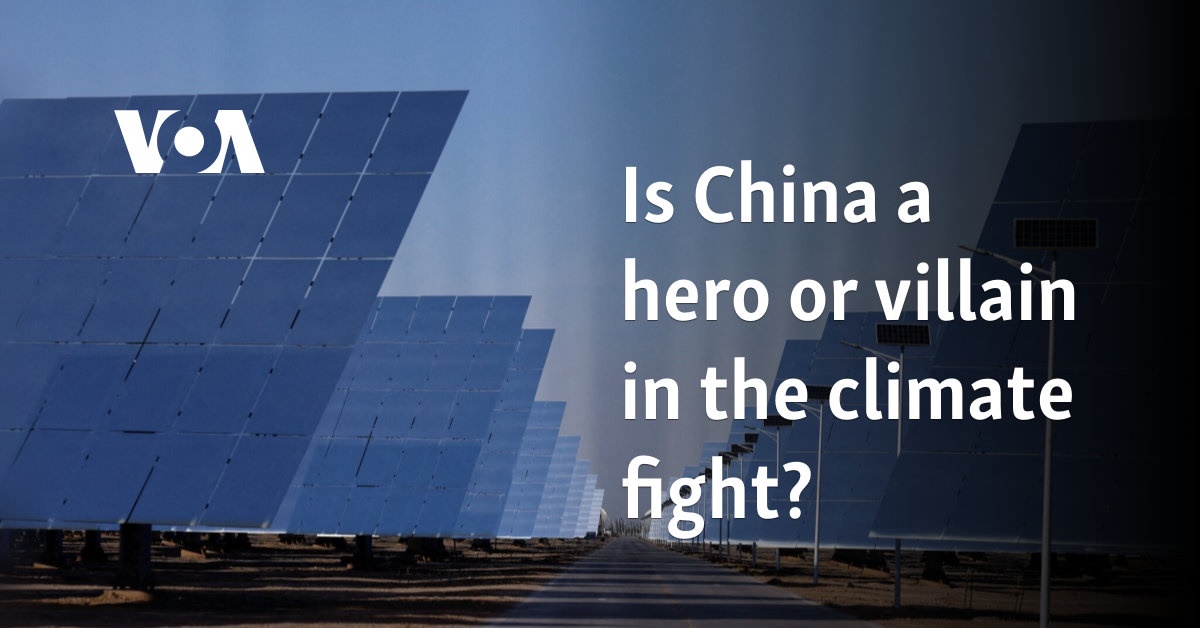Opinion | China’s clean energy transition solves several problems at once – South China Morning Post

Report on China’s Renewable Energy Strategy and Alignment with Sustainable Development Goals
1.0 Introduction: Strategic Investment in Clean Energy
This report details China’s significant investment in renewable energy, a strategic initiative aimed at stimulating economic growth and advancing the nation’s commitment to the United Nations Sustainable Development Goals (SDGs). The focus on expanding solar, wind, and hydropower capacity directly supports key global targets for a sustainable future.
2.0 Expansion of Renewable Energy Infrastructure and Capacity
China is undertaking a large-scale expansion of its renewable energy infrastructure, directly contributing to SDG 7 (Affordable and Clean Energy) and SDG 9 (Industry, Innovation, and Infrastructure). This expansion is critical for building resilient infrastructure and increasing the share of renewable energy in the global energy mix.
2.1 Growth in Solar and Wind Power
Data from the first half of 2025 indicates substantial progress:
- Solar Power: Generation capacity increased by 54.2% year-on-year.
- Wind Power: Generation capacity grew by 22.7% over the same period.
2.2 Hydropower Development
China is constructing the world’s largest hydropower project. This monumental undertaking, costing less than 1% of the nation’s GDP, underscores a long-term commitment to clean energy infrastructure, aligning with SDG 9.1 (Develop quality, reliable, sustainable and resilient infrastructure).
3.0 Economic and Energy Security Impact
The transition to renewables offers dual benefits of economic stimulation and enhanced energy security, fostering progress towards SDG 8 (Decent Work and Economic Growth).
3.1 Economic Advantages
The clean energy initiative is projected to:
- Increase domestic investment and stimulate economic activity.
- Lower supply-side costs through abundant, locally produced energy.
- Reduce the national energy import bill by an estimated 0.5% of GDP due to decreased reliance on crude oil.
3.2 Achieving Energy Independence
By leveraging its industrial capacity to produce renewable energy, China is transitioning from a reliance on imported energy to a model of energy self-sufficiency. This shift is fundamental to achieving long-term, sustainable economic prosperity as outlined in SDG 8.
4.0 Progress Towards a Green Energy Transition
Recent statistics demonstrate a significant shift in China’s energy consumption patterns, marking a turning point in its green transition and supporting SDG 13 (Climate Action).
4.1 2024 Energy Consumption Analysis
- Total Primary Energy Consumption: Equivalent to 5.96 billion tonnes of standard coal.
- Total Electricity Consumption: 9.8 trillion kilowatt-hours (kWh).
- Solar Generation: 834 billion kWh (a 44% increase from 2023).
- Wind Generation: 992 billion kWh (a 16% increase from 2023).
In 2024, solar and wind power constituted 18.5% of total electricity consumption and accounted for nearly 60% of the year’s increase in electricity demand. Projections suggest this share could rise to 80% of the consumption increase in 2025.
5.0 Advancing Energy Efficiency and Electrification
Improvements in energy efficiency and the promotion of electrification are key components of China’s strategy, aligning with SDG 11 (Sustainable Cities and Communities) and SDG 12 (Responsible Consumption and Production).
5.1 Efficiency in Power Generation and Use
- Coal Power Efficiency: China’s coal power generation is noted for its efficiency, averaging 300 grams of standard coal per kWh.
- Electric Vehicles (EVs): EVs demonstrate high energy efficiency, converting approximately 80% of energy into motion, far surpassing internal combustion engines.
The shift towards an electrified economy, powered by renewables, is crucial for reducing the environmental impact of urban centers and promoting sustainable production and consumption patterns. A fully electrified energy system in China is estimated to require around 25 trillion kWh, a goal made more attainable through the aggressive expansion of renewable sources.
SDGs Addressed in the Article
-
SDG 7: Affordable and Clean Energy
The article’s primary focus is on China’s massive investment and expansion in renewable energy sources, including solar, wind, and hydropower. It discusses increasing generation capacity, the share of renewables in electricity consumption, and the goal of energy independence through clean sources.
-
SDG 8: Decent Work and Economic Growth
The text explicitly states that the investment in renewable energy is intended to “give its economy a boost” and that “cheap and abundant renewable energy is the most important pillar of China’s long-term prosperity.” This connects the green transition directly to economic growth and stability.
-
SDG 9: Industry, Innovation, and Infrastructure
The article highlights the development of significant sustainable infrastructure, such as the construction of the “world’s largest hydropower project” and the rapid scaling of solar and wind power facilities. This represents a major upgrade of the country’s energy infrastructure towards sustainable and clean technologies.
-
SDG 13: Climate Action
While not explicitly mentioning “climate change,” the article’s entire theme of a “clean energy push” and a “green transition” away from fossil fuels (implied by “reduced consumption of crude oil”) is a core strategy for climate action. The shift to renewables is a fundamental measure to combat climate change, integrated into national economic policy.
Specific Targets Identified
SDG 7: Affordable and Clean Energy
-
Target 7.2: By 2030, increase substantially the share of renewable energy in the global energy mix.
The article directly supports this target by detailing China’s progress. It states that “solar and wind made up 18.5 per cent of total electricity consumption last year” and notes the significant year-on-year growth in generation capacity for both solar (54.2%) and wind (22.7%).
-
Target 7.3: By 2030, double the global rate of improvement in energy efficiency.
This target is addressed through the mention of highly efficient technologies. The article points out that Electric Vehicles (EVs) “convert about 80 per cent of energy into motion, substantially more efficient than cars with internal combustion engines,” highlighting a key area of improvement in energy efficiency in the transport sector.
SDG 8: Decent Work and Economic Growth
-
Target 8.4: Improve progressively, through 2030, global resource efficiency in consumption and production and endeavour to decouple economic growth from environmental degradation.
The article describes how China is decoupling its economy from imported fossil fuels by developing domestic renewable energy sources. The text notes that “renewables are giving the country the means to turn its own industrial power into energy,” thereby improving resource efficiency and fostering growth based on sustainable resources.
SDG 9: Industry, Innovation, and Infrastructure
-
Target 9.1: Develop quality, reliable, sustainable and resilient infrastructure… to support economic development and human well-being.
This is demonstrated by the article’s reference to China “constructing what is set to be the world’s largest hydropower project.” This, along with the rapid expansion of solar and wind farms, constitutes the development of new, large-scale sustainable energy infrastructure.
-
Target 9.4: By 2030, upgrade infrastructure and retrofit industries to make them sustainable, with increased resource-use efficiency and greater adoption of clean and environmentally sound technologies.
The entire “clean energy push” described in the article is an example of this target in action. China is systematically upgrading its energy industry by investing heavily in clean technologies like solar and wind, aiming for a comprehensive “green transition.”
SDG 13: Climate Action
-
Target 13.2: Integrate climate change measures into national policies, strategies and planning.
The article shows that China’s renewable energy strategy is not just an environmental policy but a core part of its economic planning. The text states that the push will “increase investment and lower supply-side costs, killing two birds with one stone,” demonstrating the integration of climate-friendly measures into national economic strategy.
Indicators for Measuring Progress
SDG 7: Affordable and Clean Energy
- Share of renewable energy: The article provides a specific figure: “Solar and wind made up 18.5 per cent of total electricity consumption last year.”
- Growth in renewable capacity: The article gives precise growth metrics: “solar power generation capacity jumped 54.2 per cent year on year, while wind power’s generation capacity increased by 22.7 per cent.”
- Absolute renewable generation: Specific generation figures are mentioned: “solar reportedly generated 834 billion kWh” and “wind generated 992 billion kWh” out of a total of “9.8 trillion kilowatt hours (kWh).”
- Energy efficiency of technology: The efficiency of EVs is quantified: “They convert about 80 per cent of energy into motion.”
SDG 8: Decent Work and Economic Growth
- Investment as a percentage of GDP: The cost of the hydropower project is cited as an indicator of economic investment: “expected to cost less than 1 per cent of China’s gross domestic product (GDP).”
- Reduction in import costs: An economic benefit is quantified: “Reduced consumption of crude oil coupled with lower prices could cut China’s energy import bill by half a per cent of GDP.”
SDG 9: Industry, Innovation, and Infrastructure
- Investment in new infrastructure: The article points to the construction of the “world’s largest hydropower project” as a key indicator of investment in new, sustainable infrastructure.
SDG 13: Climate Action
- Policy implementation: The national strategy is described as a “clean energy push” and a “green transition,” serving as a qualitative indicator of policy integration.
- Contribution of renewables to new demand: The article projects that “solar and wind could account for 80 per cent of this year’s increased electricity consumption,” indicating the scale of the transition.
Summary Table of SDGs, Targets, and Indicators
| SDGs | Targets | Indicators |
|---|---|---|
| SDG 7: Affordable and Clean Energy | Target 7.2: Increase substantially the share of renewable energy in the global energy mix. |
|
| SDG 7: Affordable and Clean Energy | Target 7.3: Double the global rate of improvement in energy efficiency. |
|
| SDG 8: Decent Work and Economic Growth | Target 8.4: Improve resource efficiency and decouple economic growth from environmental degradation. |
|
| SDG 9: Industry, Innovation, and Infrastructure | Target 9.1: Develop quality, reliable, sustainable and resilient infrastructure. |
|
| SDG 13: Climate Action | Target 13.2: Integrate climate change measures into national policies, strategies and planning. |
|
Source: scmp.com

What is Your Reaction?
 Like
0
Like
0
 Dislike
0
Dislike
0
 Love
0
Love
0
 Funny
0
Funny
0
 Angry
0
Angry
0
 Sad
0
Sad
0
 Wow
0
Wow
0













































































